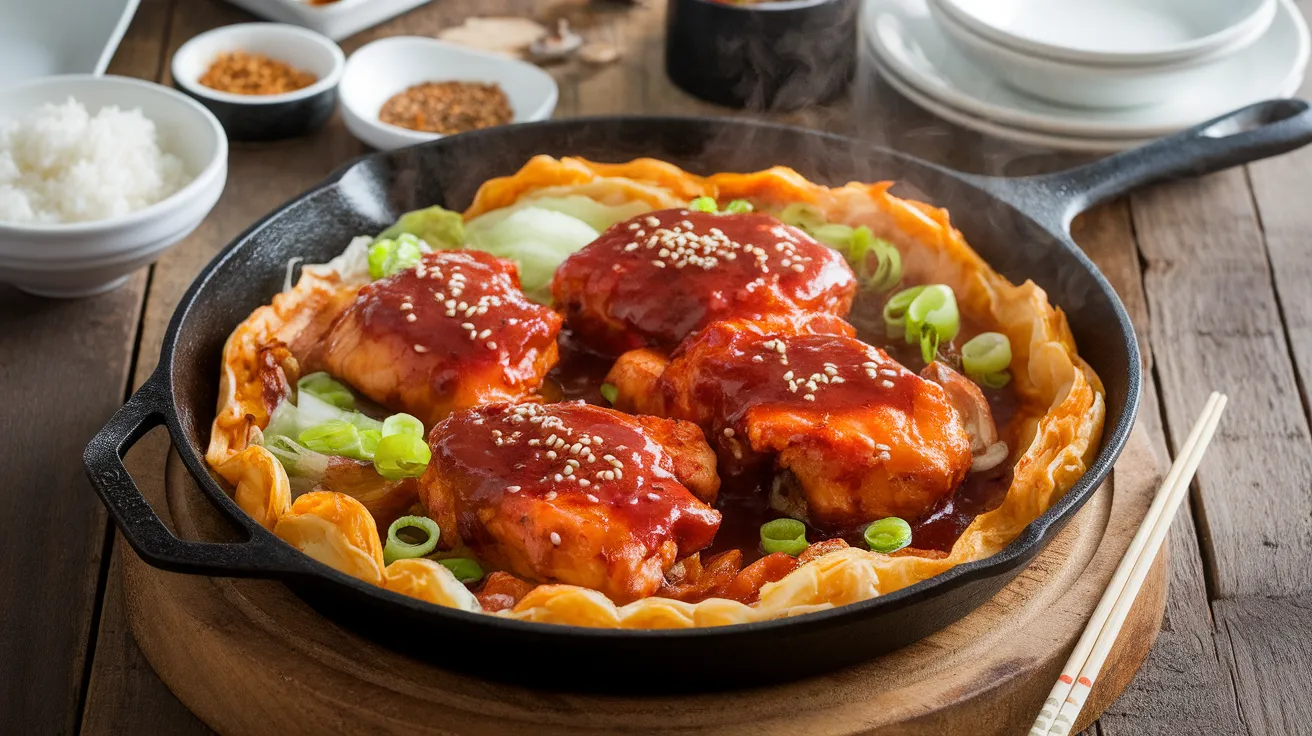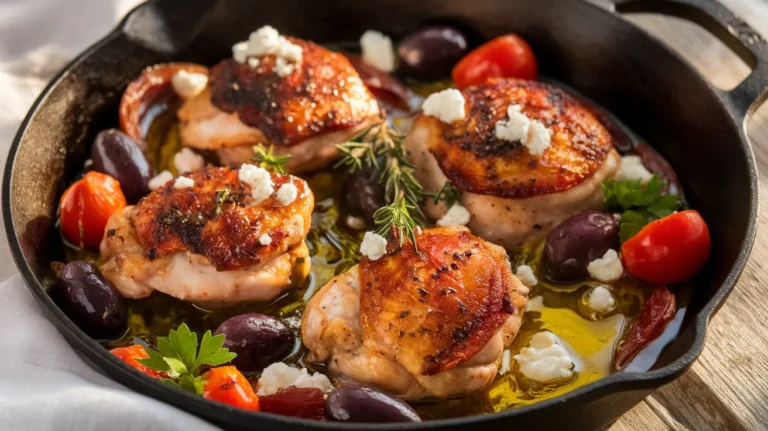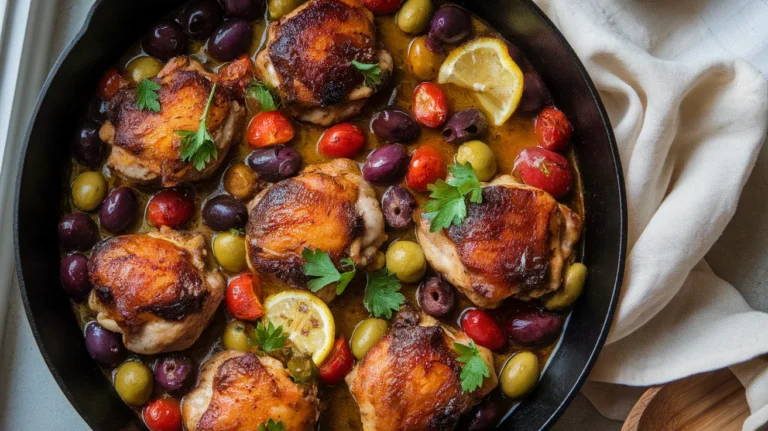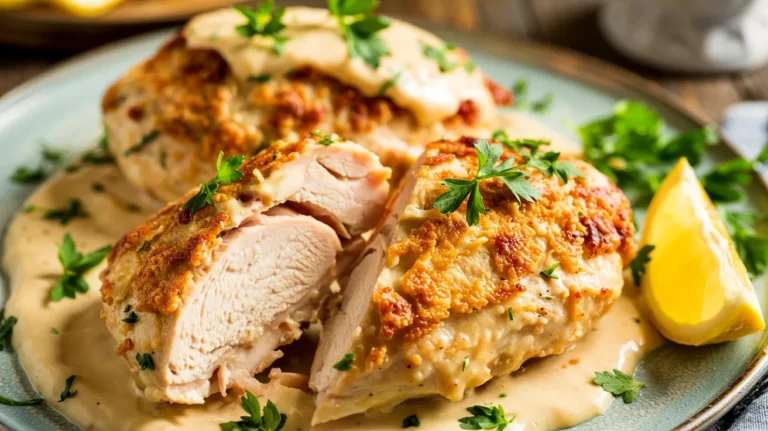This dak galbi Korean BBQ chicken brings Seoul’s most addictive street food straight to your kitchen—spicy, sweet, and so good you’ll wonder why you ever ordered delivery. Perfect for feeding four hungry souls who crave bold Korean flavors with minimal fuss.
SERVES: 4 | PREP: 20 MIN | COOK: 25 MIN | TOTAL: 45 MIN
Why This Dak Galbi Recipe Works
Forget complicated Korean recipes that need specialty ingredients you’ll never use again. This dak galbi Korean BBQ chicken uses supermarket staples to create that signature spicy-sweet flavor Koreans crave at 2 AM. The chicken gets crazy tender from the marinade, while cabbage and sweet potatoes soak up all that gorgeous red sauce.
The secret? High heat and patience. Let those flavors caramelize.
Ingredients for Dak Galbi Korean BBQ Chicken
For the Marinade
| Ingredient | Amount |
|---|---|
| Gochugaru (Korean red pepper flakes) | 3 tablespoons |
| Gochujang (Korean red pepper paste) | 2 tablespoons |
| Soy sauce | 3 tablespoons |
| Brown sugar | 2 tablespoons |
| Sesame oil | 1 tablespoon |
| Garlic (minced) | 6 cloves |
| Fresh ginger (grated) | 1 tablespoon |
| Rice wine or mirin | 2 tablespoons |
| Black pepper | ½ teaspoon |
For the Chicken & Vegetables
| Ingredient | Amount |
|---|---|
| Boneless chicken thighs (cut into 2-inch pieces) | 2 pounds |
| Green cabbage (chopped into 2-inch chunks) | 3 cups |
| Sweet potato (peeled, ½-inch thick half-moons) | 1 large |
| Korean rice cakes (tteok) – optional | 1 cup |
| Onion (sliced thick) | 1 large |
| Green onions (cut into 2-inch pieces) | 4 stalks |
| Perilla leaves or sesame leaves (torn) – optional | 8 leaves |
For Finishing
| Ingredient | Amount |
|---|---|
| Mozzarella cheese (shredded) – optional | 1 cup |
| Sesame seeds | 2 teaspoons |
| Vegetable oil | 2 tablespoons |
How to Make Dak Galbi Korean BBQ Chicken
Phase 1: Building Your Marinade (5 minutes)
Step 1: Grab a large mixing bowl and combine gochugaru, gochujang, soy sauce, brown sugar, sesame oil, minced garlic, grated ginger, rice wine, and black pepper. Whisk everything together until the sugar dissolves completely and you’ve got a thick, crimson paste. The mixture should smell intensely spicy and sweet—that’s exactly what you want. This marinade is the soul of your dak galbi Korean BBQ chicken, so don’t skip the whisking until it’s completely smooth.
Step 2: Add your cut chicken thigh pieces to the marinade. Use your hands to massage the sauce into every piece of chicken—yes, it’s messy, but this is how you guarantee maximum flavor penetration. Make sure no piece of chicken escapes without a thick coating of that gorgeous red marinade. The chicken should be completely coated, almost like it’s wearing a spicy jacket.
Step 3: Cover the bowl with plastic wrap and let it sit at room temperature for 15 minutes while you prep vegetables. This short marinating time lets the flavors start working into the meat. If you’re meal-prepping, you can marinate this up to 24 hours in the fridge—the chicken will be even more flavorful, though 15 minutes works perfectly fine for weeknight cooking.
Phase 2: Vegetable Preparation (8 minutes)
Step 4: Slice your sweet potato into ½-inch thick half-moons. This thickness is crucial—too thin and they’ll disintegrate, too thick and they won’t cook through before the chicken dries out. Sweet potatoes add a subtle sweetness that balances the heat from the gochugaru, and they become creamy and tender as they absorb the spicy sauce.
Step 5: Chop your cabbage into roughly 2-inch chunks. Don’t worry about being precise here—irregular pieces actually work better because they create different textures as they cook. Some pieces will stay slightly crunchy while others soften completely, giving you textural variety in every bite.
Step 6: Slice the onion into thick wedges (about ½-inch thick), keeping some of the layers connected. These thick slices won’t fall apart during cooking and will develop sweet, caramelized edges that contrast beautifully with the spicy chicken. Cut your green onions into 2-inch batons and set them aside—they’ll go in during the last few minutes.
Step 7: If you’re using rice cakes (tteok), soak them in cold water for 5 minutes to soften. Drain well before using. These chewy rice cakes are traditional in dak galbi and add an addictive texture that makes this dish feel more substantial. Skip them if you can’t find them—the dish is still incredible without them.
Phase 3: The Cook (15 minutes)
Step 8: Heat a large, wide skillet or wok over high heat until it’s screaming hot—about 2 minutes. Add vegetable oil and swirl to coat. The pan needs to be hot enough that a drop of water sizzles and evaporates immediately. This high heat is essential for getting that slightly charred, caramelized flavor that makes restaurant dak galbi Korean BBQ chicken so addictive.
Step 9: Add the marinated chicken to the pan in a single layer as much as possible. Don’t stir for the first 2 minutes—let it sear and develop a slightly crispy, caramelized crust. You should hear aggressive sizzling. This crust adds depth and complexity to the final dish. After 2 minutes, stir the chicken and let it sear on another side for 1-2 minutes.
Step 10: Add the sweet potato slices around the chicken. The sweet potatoes need a head start because they take longer to cook than the other vegetables. Stir them occasionally to coat with the marinade. Cook for 5 minutes, stirring every minute or so. The sweet potatoes should start to soften around the edges but still have some firmness in the center.
Step 11: Add the cabbage chunks, onion wedges, and rice cakes (if using) to the pan. Everything will seem crowded—that’s perfect. Stir everything together so the vegetables get coated in that spicy marinade. The cabbage will release moisture as it cooks, creating more sauce. Cook for 5 minutes, stirring frequently, until the cabbage starts to wilt and turn tender-crisp.
Step 12: Add the green onions and perilla leaves (if using). Stir everything together and cook for 2 more minutes. The chicken should be fully cooked through (internal temperature of 165°F), the sweet potatoes should be fork-tender, and the cabbage should be wilted but still have some bite. If the pan looks too dry, add 2-3 tablespoons of water to create more sauce.
Phase 4: The Cheesy Finish (Optional, 5 minutes)
Step 13: If you want to go full Korean BBQ restaurant style, push all the dak galbi Korean BBQ chicken and vegetables toward the center of your pan, creating a ring around the edge. Sprinkle shredded mozzarella cheese in that outer ring. Let it melt without stirring for 2-3 minutes until the edges get crispy and golden. The contrast between spicy chicken and mild, gooey cheese is ridiculously good.
Step 14: Once the cheese is melted and starting to bubble, turn off the heat. Sprinkle sesame seeds all over the top. The residual heat will toast them slightly, bringing out their nutty flavor.
Step 15: Serve immediately, family-style, right from the pan. Provide everyone with a bowl of steamed rice and let them dig in. The proper way to eat this is to wrap some chicken, vegetables, and cheese (if you used it) in a lettuce leaf with rice, but eating it straight from the pan with chopsticks is equally authentic.
Chef’s Notes for Perfect Dak Galbi
Chicken thighs over breasts: Dark meat stays juicy even with high-heat cooking. Breasts will dry out before the vegetables are done, leaving you with sad, chalky chicken. Thighs have enough fat to stay tender while absorbing all that gorgeous marinade.
Adjust the heat level: Traditional dak galbi Korean BBQ chicken is seriously spicy. If you’re heat-sensitive, cut the gochugaru down to 1-2 tablespoons. You can always serve extra gochugaru on the side for the spice lovers at your table.
Pan size matters: Use your largest skillet—at least 12 inches wide. Crowding everything into a small pan will steam the ingredients instead of searing them, and you’ll miss out on those caramelized, slightly charred bits that make this dish special.
Make it a complete meal: While this recipe serves four as a main dish, pair it with simple sides like Mediterranean olive oil chicken for a fusion dinner party, or contrast it with milder options like Thai coconut curry chicken to offer your guests variety.
Nutrition Information (Per Serving)
Calories: 485 | Protein: 38g | Carbohydrates: 32g | Fat: 22g | Fiber: 4g | Sodium: 920mg
Creative Variations
Spicy Pork Dak Galbi: Swap chicken for thinly sliced pork belly or pork shoulder. The fattier meat becomes incredibly tender and rich. Reduce cooking time by 3-4 minutes since pork cooks faster in thin slices.
Seafood Version: Replace half the chicken with squid, shrimp, and mussels added in the last 5 minutes of cooking. The seafood soaks up the spicy marinade beautifully while staying tender.
Vegetarian Dak Galbi: Use extra-firm tofu (pressed and cubed) and mushrooms (shiitake, oyster, or king oyster) instead of chicken. Add an extra tablespoon of gochujang for umami depth. The tofu becomes incredibly flavorful as it absorbs the marinade.
Dak Galbi Fried Rice: Turn leftovers into next-level fried rice. Chop up the leftover chicken and vegetables, stir-fry with cooked rice, and crack a couple eggs into the mix. It’s even better than the original dish.
Storage & Reheating
Refrigerator: Store cooled dak galbi in an airtight container for up to 4 days. The flavors actually deepen and improve after a day in the fridge as the vegetables continue marinating in that spicy sauce.
Freezer: Freeze in portion-sized containers for up to 3 months. Let it cool completely before freezing to prevent ice crystals from forming.
Reheating: Reheat in a skillet over medium-high heat with a splash of water or chicken broth to loosen the sauce. Microwave reheating works but won’t give you those crispy, caramelized edges. Add fresh green onions after reheating to brighten everything up.
Make-ahead strategy: Marinate the chicken up to 24 hours ahead and prep all vegetables. Store them separately in the fridge. When ready to cook, the actual cooking time is just 25 minutes—perfect for busy weeknights.
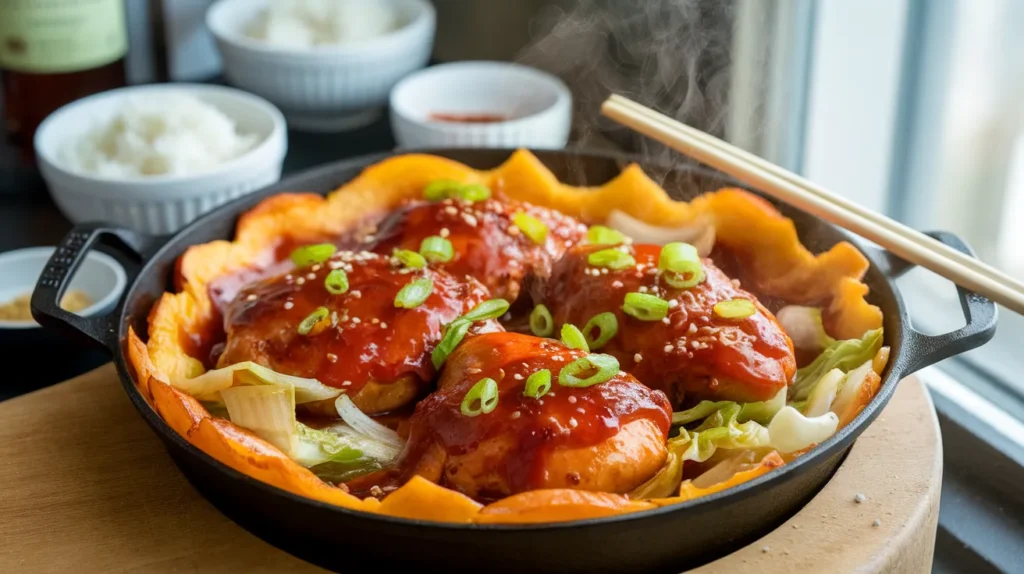
Troubleshooting Common Problems
Problem: Chicken is dry and overcooked
Solution: You’re using chicken breasts or cooking too long. Switch to thighs and check for doneness at 20 minutes total cooking time. Thighs are forgiving and stay moist even if slightly overcooked.
Problem: Vegetables are mushy and watery
Solution: Your heat isn’t high enough. Crank it up so vegetables caramelize instead of steam. Also, don’t cover the pan at any point—trapped moisture makes everything soggy.
Problem: Not spicy enough
Solution: Gochugaru loses potency over time. Check your Korean red pepper flakes—if they’re more than 6 months old, double the amount. Fresh gochugaru has vibrant color and intense heat. You can also add extra gochujang for deeper spice.
Problem: Too salty
Solution: Balance it with a teaspoon of sugar and a squeeze of lemon juice. Next time, use low-sodium soy sauce or reduce it to 2 tablespoons. The gochujang already contains salt, so the soy sauce can push things over the edge.
Problem: Sauce is too thick and burning
Solution: Add water or chicken broth, 2 tablespoons at a time, to thin the sauce. The vegetables should release moisture as they cook, but if your pan is too hot or your vegetables are old, they might not release enough liquid. Keep a small bowl of water nearby for quick adjustments.
Equipment Essentials
- Large skillet or wok (12-14 inches): Essential for high-heat cooking without crowding
- Sharp chef’s knife: For clean vegetable cuts that cook evenly
- Cutting board: Large surface for all that veggie prep
- Mixing bowls: One large for marinating, one medium for prepped vegetables
- Measuring spoons and cups: Korean cooking is precise—eyeballing won’t work
- Wooden spoon or spatula: Metal can scratch your pan during aggressive stirring
- Grater or microplane: For fresh ginger—jarred ginger won’t give you the same punch
- Instant-read thermometer (optional): Takes the guesswork out of chicken doneness
Shopping List by Store Section
Produce Section:
- Garlic (6 cloves)
- Fresh ginger (1 knob)
- Green cabbage (½ small head)
- Sweet potato (1 large)
- Onion (1 large)
- Green onions (1 bunch)
- Perilla leaves (optional, 1 package)
Meat Counter:
- Boneless chicken thighs (2 pounds)
International/Asian Aisle:
- Gochugaru (Korean red pepper flakes)
- Gochujang (Korean red pepper paste)
- Rice wine or mirin
- Sesame oil
- Korean rice cakes/tteok (optional)
Pantry Aisle:
- Soy sauce
- Brown sugar
- Sesame seeds
- Vegetable oil
Dairy (Optional):
- Mozzarella cheese (1 cup shredded)
Success Secrets from the Pros
1. Temperature is everything: Your pan should be hot enough that the marinade caramelizes instead of steaming. If you see lots of liquid pooling in the pan, your heat is too low. Crank it up until you hear aggressive sizzling.
2. Don’t skimp on marinating time: Even 15 minutes makes a difference, but overnight marination transforms this dak galbi Korean BBQ chicken into restaurant-quality food. The enzymes in the ginger and garlic break down the chicken, making it incredibly tender.
3. Use your hands to mix: It feels weird, but massaging the marinade into the chicken with your hands ensures every piece is evenly coated. Spoons and spatulas can’t distribute the thick paste as effectively.
4. Keep ingredients similar in size: Cut everything roughly the same size so it cooks evenly. Nothing worse than raw sweet potatoes with overcooked chicken because you cut the potatoes too thick.
5. Serve immediately: Dak galbi is best eaten straight from the pan while everything is still sizzling. The vegetables lose their crisp-tender texture and the cheese hardens as it cools. Make this a “gather everyone at the table first” kind of meal.
